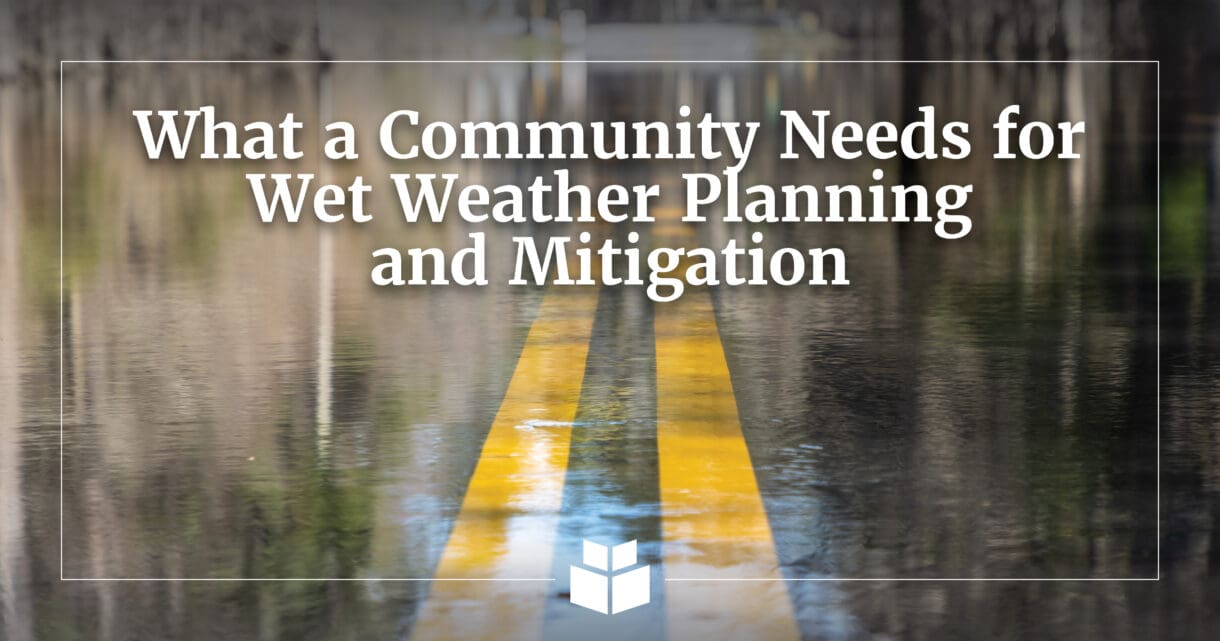
Since the dawn of humanity, our endeavors have at the very least been to understand and, if possible, rein in the effects of the elements, often manifested through weather events, to create conditions of livability.
As storms intensify and weather patterns fluctuate, for communities, it becomes imperative to plan ahead and ensure operational and functioning infrastructure during and after storms. WithersRavenel’s utilities and stormwater teams provide wet weather planning and flood mitigation, through which sewer and wastewater treatment infrastructure can be protected.
Getting started
To be effective, it all starts with the collection and review of the physical characteristics of the sewer system through an asset management plan (AMP). This is typically followed by a thorough evaluation of the localities’ sewer infrastructure based on a desired level of service and future build-out. Once the locality has used this evaluation to characterize the performance of their system, they can prioritize recommendations for improvement within their capital improvement plan (CIP) to remedy the sites at the root of frequent Sanitary Sewer overflows (SSOs).
Once an AMP is in place, the evaluation of the system begins with compiling a model of the physical sewer system elements using GIS, flow monitoring data, and site survey data, where available. Flow monitoring data at the site assists with predicting how different rain events will strain infrastructure.
Modeling weather events
“The overarching thought of a wet weather mitigation plan is to determine what you need to be looking for during rain events that impact the sewer capacity and then also to determine what you need to be putting in your CIP and what would help the locality as a whole instead of just doing find-and-fix,” says WithersRavenel Senior Utilities Project Manager Cathleen Saunders, PE, who has helped communities draw up plans for reducing rainfall derived infiltration and inflow (RDII) to their sewer systems.
“You simulate the sewer system using a dynamic hydraulic model based on the different levels of information you have, what types of rain events you typically get, and then from there you would determine how that would affect the system each time it rains and what level of service should be evaluated,” according to Cathleen. “It could just be a storm that regularly falls across that sewershed, and then you model it using the RDII obtained via monitoring on site.”
Ensuring accuracy in data
Collecting and compiling data for a model can, however, be challenging, Cathleen says. Flow monitors and rain gauges (such as ADS sensors) track sewer volume and rainfall intensity. This data is checked regularly for accuracy. But often, GIS records may not be up to date for reasons such as incomplete asset information.
Cathleen says once data is compiled and evaluated, it could reveal bottlenecks such as undersized pipes or failing pump stations that cause SSOs. Solutions would fall into the category of separating storm and sanitary sewers, flow equalization, or satellite treatment, but recommendations could be as simple as upsizing infrastructure or upgrading pump stations.
All about the sewer system
While wet weather planning is targeted primarily at sewer infrastructure, there is an opportunity for a stormwater mitigation component to it. “It is more of a sewer (system) problem, just the I&I (infiltration and inflow) itself,” says Dori Sabeh, PE, GISP, WithersRavenel’s Director of Stormwater. Alleviating (surface) flooding in the affected areas brings added value, he says. “You will not have water going through manholes and into the sanitary sewer pipes,” he says.
“Flooding” might create the notion that wet weather planning is a stormwater control issue, but as Dori explains, it is not. Sometimes, just a high groundwater level will cause continuous flow into the sewer system even when it isn’t raining. This is particularly important in low-lying or coastal areas with high water table and “sunny-day” flooding concerns.
A variety of factors can lead to SSOs, primarily older sewers that are vulnerable to both groundwater and stormwater, even during minor rainfall events. While extreme weather exacerbates overflows, even routine rainfall can overwhelm systems because stormwater flows are typically orders of magnitude higher than the design flows for sanitary sewers.
Going for the longer run
While short-term solutions remain an option, especially in emergencies, comprehensive and long-term solutions remain the most effective way to minimize the effects of SSOs. Using CIPs and leveraging state/federal funding such as Asset Inventory & Assessment (AIA), State Revolving Fund (SRF), and Hazard Mitigation and Resiliency grants, can provide the resources to undertake large-scale upgrades to the sewer system.
For communities looking to undertake wet weather planning and flood-risk management of sewer systems, modeling and monitoring are critical to anticipating failures, along with planned, long-term investments in infrastructure that build resilience to current and future hazards.
WithersRavenel’s multidisciplinary approach can help communities with a holistic approach to wet weather planning and mitigation with our utilities, stormwater, land planning, GIS, and funding and asset management expertise. Reach out to Dori Sabeh, PE, GISP, at dsabeh@withersravenel.com to learn more.
